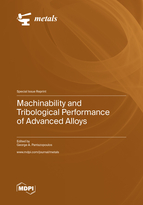Machinability and Tribological Performance of Advanced Alloys
A special issue of Metals (ISSN 2075-4701). This special issue belongs to the section "Metal Failure Analysis".
Deadline for manuscript submissions: closed (1 May 2023) | Viewed by 31398
Special Issue Editor
Interests: failure analysis; fracture analysis; fractography; fracture mechanics; mechanical behavior of materials; metallography; scanning electron microscopy; manufacturing technology; materials processing; machinability; surface engineering; corrosion; tribology; quality assurance; design of experiments
Special Issues, Collections and Topics in MDPI journals
Special Issue Information
Dear Colleagues,
Machining constitutes one of the most significant categories of manufacturing processes, dedicated in final component production, including also special, precision parts and difficult-to-machine materials. The challenging aspects of this topic arise from the continuously evolving quality and productivity requirements in modern industry, together also with the innovative aspects of new and smart materials in combination with the energy and environmental (green/clean) regulations imposed in industry. In general, among conventional machining operations, high-end modern material removal processes are also included in the subject of the Special Issue (e.g., using high-energy beams such as laser machining).
The tribological performance of alloys plays an important role in the production or service environment, which is closely related to their manufacturing characteristics, and it is therefore considered as a combined topic in the frame of this Special Issue. The study of tribological behavior more diligently addresses the surface engineering aspects of modern and conventional alloys, either in bulk or in coating form, in a more generic context of industrial component production and endurance in a severe working environment.
The core subject of this Special Issue is the elaboration and presentation of studies focusing on the alloy design, manufacturing, testing, and characterization in order to provide a clear insight on the machinability and/or tribological behavior. Improvement of these closely adherent properties has led to the development of new alloy chemistries, novel engineered microstructures, and the application of coatings that lead to higher machinability and/or tribological endurance under aggressive service conditions. The environmental and health and safety regulations demand the use of ecofriendly components where human health and safety is compulsory. The manufacture of antimicrobial copper alloys in healthcare facilities and the elimination of lead in brass components for drinking water applications constitute representative examples, showing the modern industrial trends.
The optimization of machinability and tribological performance, altering also the manufacturing and service conditions, is also another core subject in this topic. The application of surface processes to enhance the tribological performance of the alloys is also a challenging topic to be addressed in this Special Issue. This Special Issue aims to gather and disseminate research knowledge in the most recent advances, collecting original high-quality papers in the field of the machinability and tribological performance of advanced alloys.
This Special Issue also welcomes papers from conference works, such as International Conference of Engineering Against Failure (ICEAF VI) and the 13th International Conference of Mechanical and Aerospace Engineering 2022 (13th ICMAE 22), to be held in Bratislava, 20-22 July 2022. For more information please visit https://iceaf.eu/2021/publication_policy and http://www.icmae.org/.
Dr. George A. Pantazopoulos
Guest Editor
Manuscript Submission Information
Manuscripts should be submitted online at www.mdpi.com by registering and logging in to this website. Once you are registered, click here to go to the submission form. Manuscripts can be submitted until the deadline. All submissions that pass pre-check are peer-reviewed. Accepted papers will be published continuously in the journal (as soon as accepted) and will be listed together on the special issue website. Research articles, review articles as well as short communications are invited. For planned papers, a title and short abstract (about 100 words) can be sent to the Editorial Office for announcement on this website.
Submitted manuscripts should not have been published previously, nor be under consideration for publication elsewhere (except conference proceedings papers). All manuscripts are thoroughly refereed through a single-blind peer-review process. A guide for authors and other relevant information for submission of manuscripts is available on the Instructions for Authors page. Metals is an international peer-reviewed open access monthly journal published by MDPI.
Please visit the Instructions for Authors page before submitting a manuscript. The Article Processing Charge (APC) for publication in this open access journal is 2600 CHF (Swiss Francs). Submitted papers should be well formatted and use good English. Authors may use MDPI's English editing service prior to publication or during author revisions.
Keywords
- Machinability
- Ecofriendly alloys
- Antimicrobial alloys
- Novel and conventional machining processes
- Optimization of machining parameters
- Tribological behavior of alloys
- Tribological behavior of coatings
- Manufacturing of machinable alloys
- High wear resistance alloys and coatings
- Nanostructured coatings






